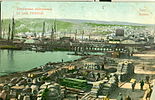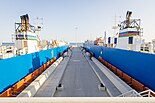Port of Baku
| Baku International Sea Trade Port CJSC (Port of Baku) | |
|---|---|
 | |
 Click on the map for a fullscreen view | |
| Location | |
| Country | Azerbaijan |
| Location | Baku |
| Coordinates | 40°14′03″N 49°31′32″E / 40.2343°N 49.5256°E |
| UN/LOCODE | AZBAK |
| Details | |
| Opened | 1902 |
| Owned by | Azerbaijani government, (Parent Company AZCON Holding) |
| No. of berths | 13 |
| Draft depth | 7.0 m. |
| Statistics | |
| Annual cargo tonnage | |
| Annual container volume | |
| Website portofbaku | |
Port of Baku, located on the ancient Silk Road connecting Europe and Asia, is a prime transport and logistics hub of Eurasia. It covers an area of 400 hectares. Being an important segment of the Trans-Caspian International Transport Route, the Port of Baku with its modern operating system provides prompt cargo services, as well as has at its disposal open and covered storage facilities designed for all types of cargo.
History
The Arab travelers of the 10th century, such as Ibn Haukal and Al-Mugaddasi, along with European maps like the Catalan map from 1375, which referred to the Caspian Sea as the “Sea of Baku,” and notes by Azerbaijani geographer Abdurrashid Bakuvi, provide valuable insights into the historical significance of the Port of Baku.[1] Additionally, travelers and scholars such as Marco Polo (13th century), Adam Olearius (17th century), Afanasiy Nikitin (15th century), and Evliya Chelebi (17th century) contribute to a comprehensive understanding of Baku's international relations.[2] Historical documents and records confirm Baku's role as a major port on the Caspian Sea, engaging in trade with various states. Notably, the 1564 decree by Safavid ruler Tahmasib I, appointing Sheikh Zahid as the first minister of the Baku port, and the “Russian campaign” agreement of Great Britain regarding communication between Russia, Iran, and Azerbaijan along the Volga-Caspian route, highlight the port's significance.[3] The Baku Trade Port Authority, which began operations on July 21, 1902, established the Port of Baku as the busiest port in the Russian Empire, surpassing even Saint Petersburg in cargo transshipment. By 1911, eight out of the nine motor ships in the Russian fleet were based at Baku.[4]
Modern Port of Baku
Port of Baku located 70 km from the capital Baku, at the junction of the main railways and highways of Azerbaijan and has 13 berths, including a Ro-Ro, a ferry terminal and a general cargo terminal.[5] With the completion of the first stage of port construction in 2018, its capacity increased to 15 million tons of cargo and 100,000 TEU equivalent containers. A project for the second stage of port construction is also being developed, after the implementation of which its annual throughput capacity can be increased to 25 million tons and 500,000 TEU containers. Furthermore, its new fertilizer terminal that will have the capacity to handle 2.5 million tons annually is under construction. Through this terminal, regular transportation of fertilizers from the countries of Central Asia, which possess them in large quantities, to the West countries through the territory of Azerbaijan will be carried out. The facility will have two warehouses with a total capacity of 60,000 tons, and state-of-the-art conveyor systems to unload the various types of fertilizers directly to warehouses or into wagons/rail hoppers at a newly designed wagon loading station. A project for the construction of a wheat terminal and a TIR parking in the port area has also been prepared.
Technical capacities
| sections | capacities |
|---|---|
| Total lifting capacity | 15 million tons/year |
| Container loading capacity | 100,000 TEU/year |
| Ferry terminal | 6.2 million tons/year |
| General cargo | 1.8 million tons/year |
| Ro-Ro processing capacity | 60,000 wheeled vehicles/year |
| Passenger capacity | 150,000/year |
| Planned capacity of the vessel | 7,000 – 10,000 tons |
| Planned length of the ship | 150-160 m. |
| Closed warehouse area | 9400 sq.m |
| Open warehouse area | 35000 sq.m |
Green Port
In 2019, for the first time among the countries of the Caspian region, the Port of Baku was awarded the “Eco Ports” (Green Port) certificate of the European Sea Ports Organization, and in 2021 it successfully passed re-certification. In addition, in 2022, it joined the UN Global Compact. Thus, the strategic activity of the port is aimed to contribute to 11 of the 17 UN Sustainable Development Goals.

The Port Environment Review System (PERS) of the European Sea Ports Organization (ESPO) presented the "EcoPorts" certificate to the Port of Baku. The Port Environment Review System (PERS) is an environmental management standard for the European port sector that raises environmental awareness and helps ports achieve sustainable development goals. This standard promotes the application of advanced technologies, especially in aspects of energy use, waste management, air quality, digitization and automation. As a result of continuous and extensive application of the mentioned standards, the Port of Baku has been able to renew this certificate for the 3rd time.

The Port of Baku has set a goal to reach zero net emissions by the year 2035 with its Climate Strategy 2035 Action Plan. Vessel emissions constitutes 71% of the total emissions. Additionally, many green projects have been implemented in the port area. 60,000 trees have already been planted with a goal to reach 100,000 by 2025. Eco-cars are now being utilized at the port as well. Overall, the Port of Baku area is the home to wide range of wild species including migrating flamingoes, swans, seagulls, cormorants, etc.
Roboport
The Port of Baku has initiated robotics, coding and STEAM course called Roboport for Alat schoolchildren. The course gives students the opportunity to develop 21st century skills and grow the technology manufacturers of the future. This project aims to teach and develop basic knowledge related to coding and technology to children from an early age. The course operating under the slogan "Engineers of the future grow here" is equipped with modern technological equipment, participants will be involved in practical training by local and foreign professionals.
Gallery
- Baku International Sea Trade Port
- Port of Baku in 1900ss
- Old Cargo Terminal
- Old Cargo Terminal
- Ferry Terminal
- Ferry Terminal
- Ferry Terminal
See also
References
- ^ "Ilham Aliyev inaugurated RO-RO terminal at Baku International Sea Trade Port complex » Official web-site of President of Azerbaijan Republic". president.az.
- ^ "Ilham Aliyev attended opening of Baku International Sea Trade Port Complex » Official web-site of President of Azerbaijan Republic". president.az.
- ^ "Port of Baku: the Eurasian trade hub working to accelerate growth". euronews. 24 April 2024.
- ^ "Port of Baku". www.bbc.com.
- ^ "Бакинский порт провел оригинальную акцию, посвященную Дню Республики - ФОТО - ВИДЕО". 1news.az (in Russian).







